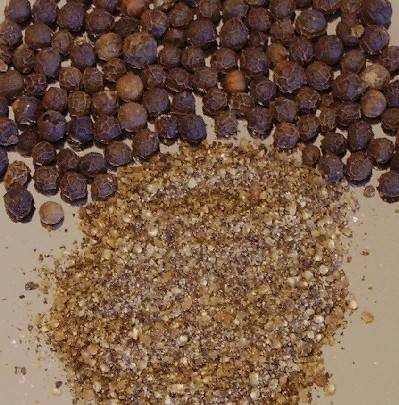Greek name and pronunciation:
Piperi, πιπέρι, pronounced pee-PEH-ree
At the market:
Black and white peppercorns and ground pepper are usually readily available at the market. Green peppercorns, packed in brine or freeze-dried, are generally available as well.
Physical characteristics:
Pepper is a vine that produces clusters of berries which look like a foot-long length of knotted rope or a strand of DNA. Black peppercorns are about 1/8th inch diameter, with a shriveled appearance caused by sun drying of the immature berries. White peppercorns are smooth spheres without outer skin. Pickled green peppercorns are smooth-skinned, pale green berries; dried, they’re green and shriveled.
Usage:
The important thing about pepper is the grind.
- If added to food during cooking, use a fine grind.
- If added to prepared food on the plate, use a coarser grind.
- In marinades, it’s best cracked with a mortar and pestle.
White pepper doesn’t show up in mayonnaise and white sauces; green goes exceptionally well with pepper steak; red goes well with wine sauces for meats and with chicken, and black goes with everything.
Substitutes:
coriander seeds
Origin, History, and Mythology:
Pepper is now so commonplace that it is probably taken for granted; however, in ancient times, it was so precious that it was used as money.
America’s first millionaire, Elias Haskett Derby, won his fortune in the American pepper trade in the early 1800s.

